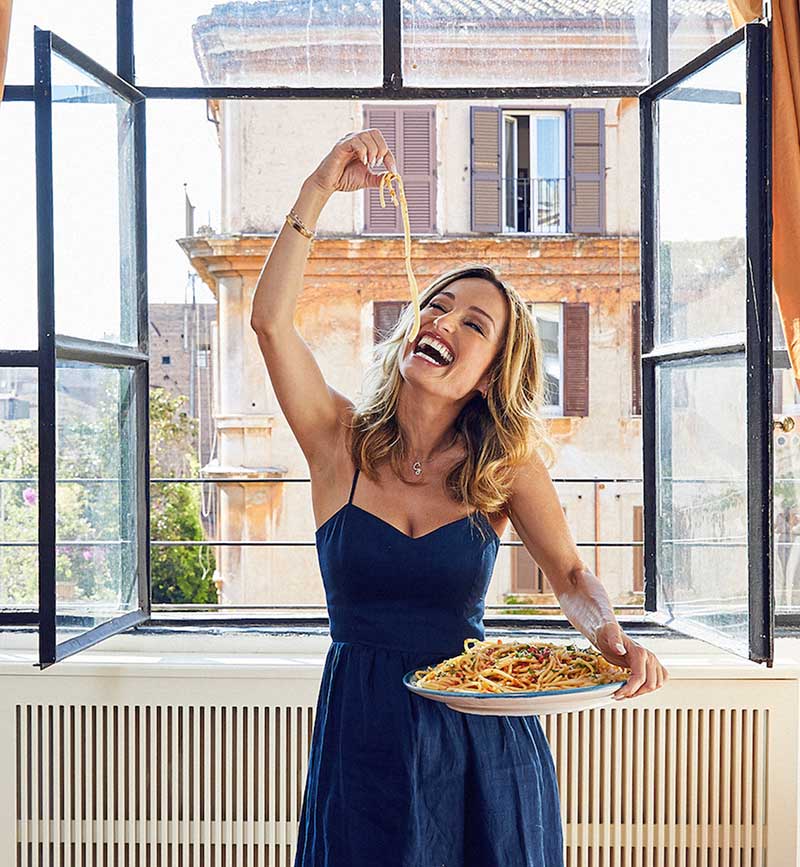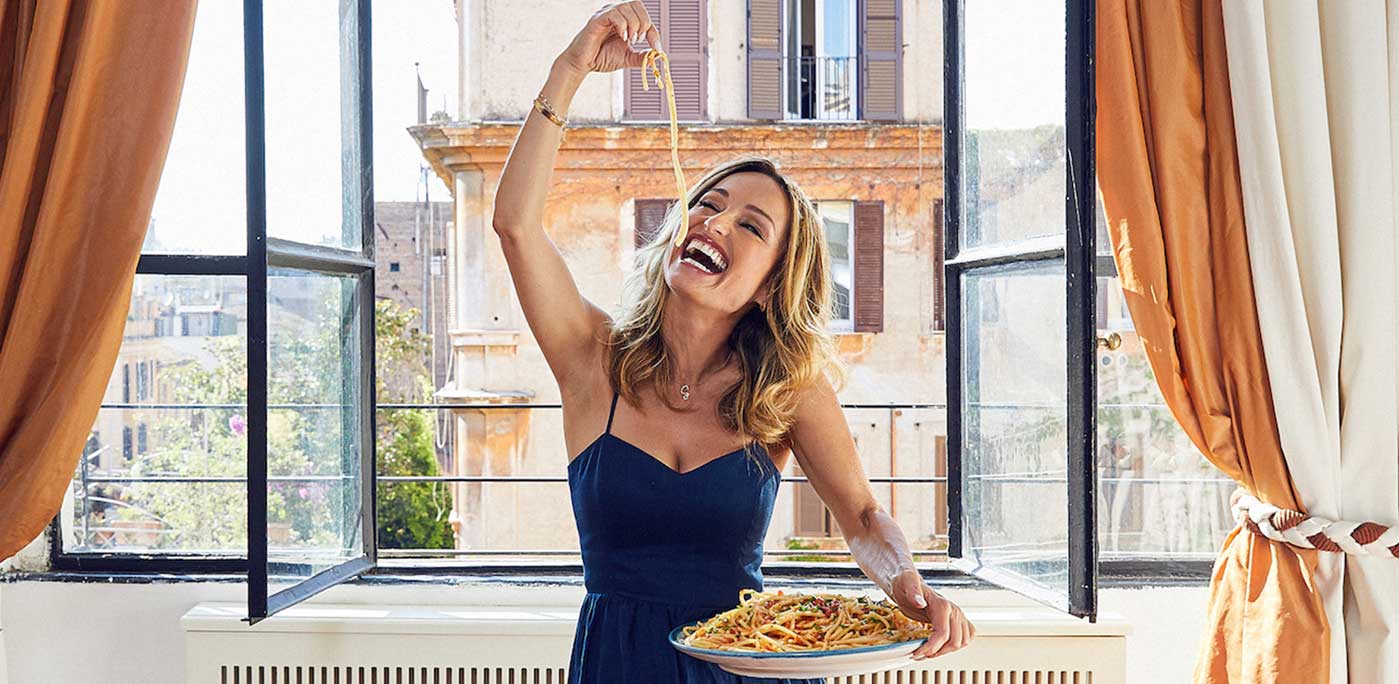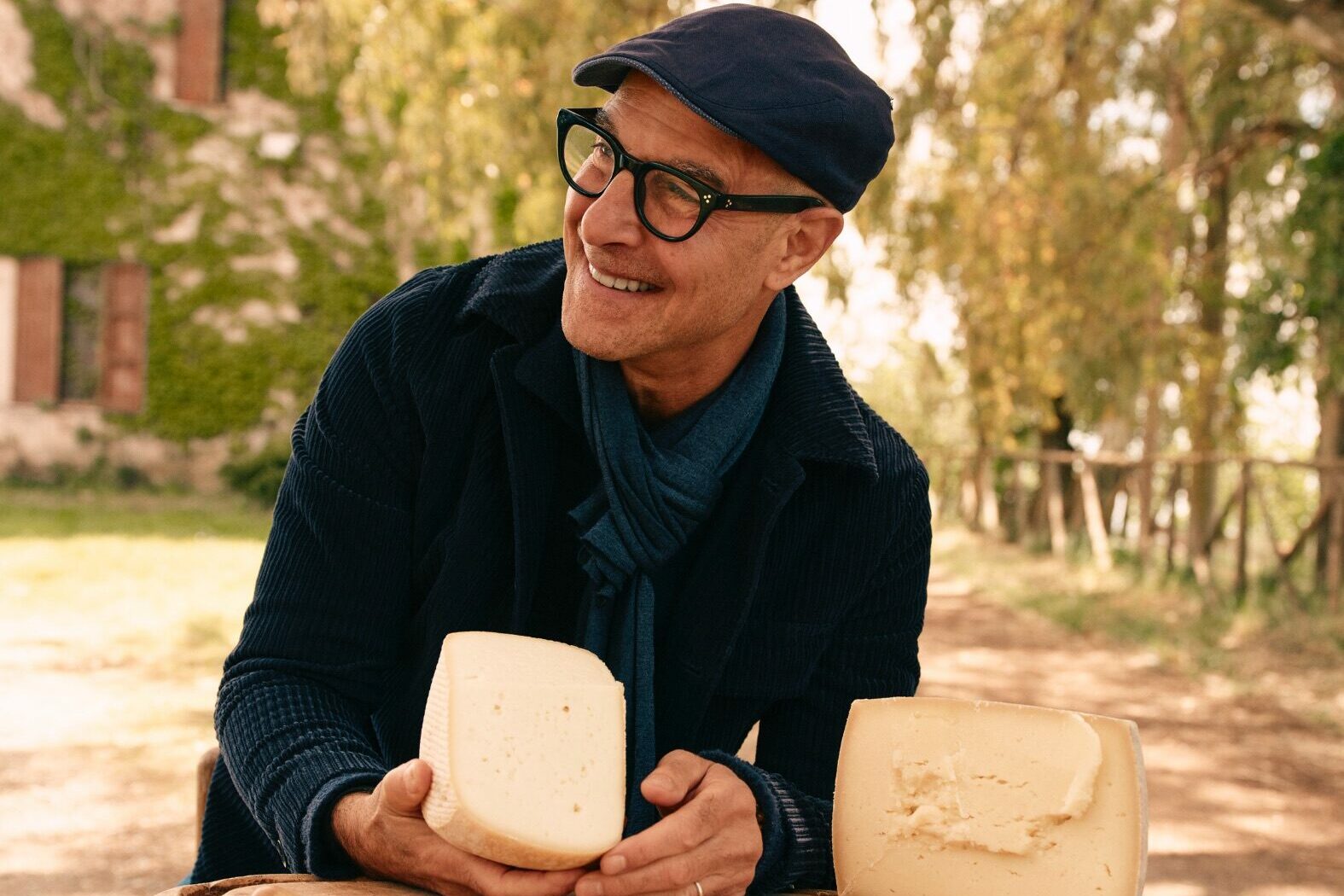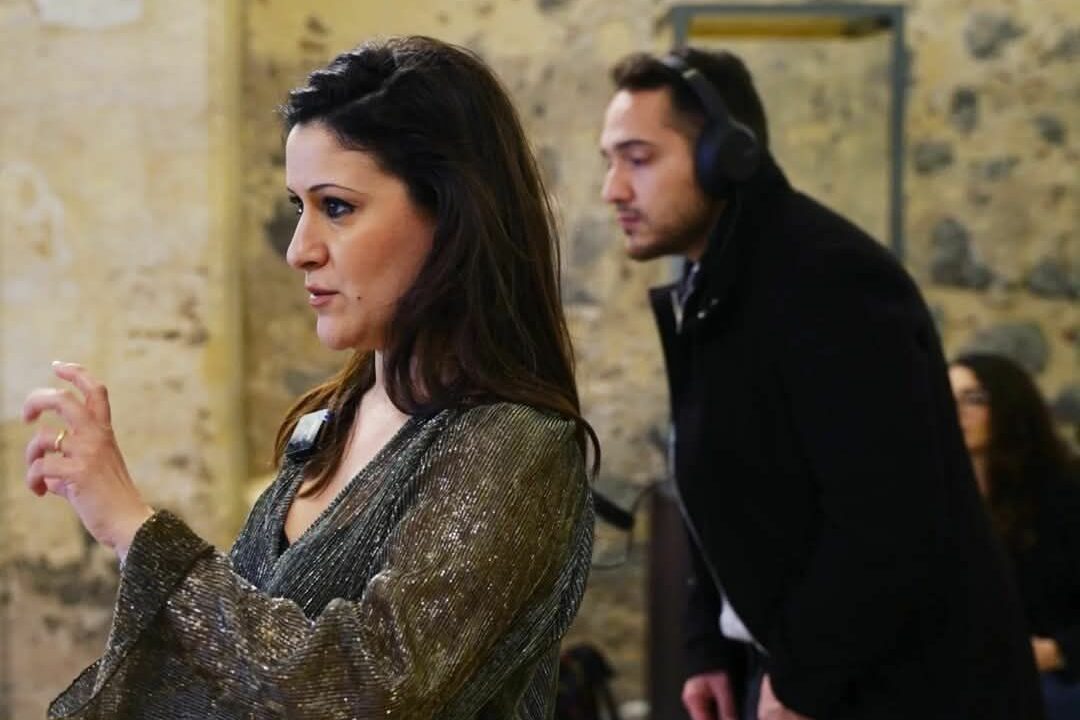“Cooking with my grandfather Dino is one of my earliest memories.” In going down memory lane, Giada De Laurentiis gets emotional. With such an important last name she was expected to work in the film industry, as the grandfather she is recalling is Dino De Laurentiis, one of the producers who brought Italian cinema to the international scene at the end of World War II.
He, in fact, produced and co-produced more than 500 films, 38 were of which were nominated for the Academy Awards. Among his biggest successes, Federico Fellini’s 1954 Oscar winning The Road, 1973 Serpico, starring Al Pacino and directed by Sidney Lumet, and Three Days of the Condor by Sidney Pollack, just to name a few. If this weren’t enough, Giada’s grandmother was Italian actress Silvana Mangano, worldwide famous protagonist of the movie Bitter Rice.

Far from being only a chef and a TV personality, Giada has also written nine cookbooks
“I moved to America when I was six. My family would do what my grandfather said: he left and so we all went with him.” She recalls.
But Giada De Laurentiis succeeded in finding her own path by pursuing a culinary career, which actually doesn’t really come as a surprise. Cooking is a part of her heritage: she in fact comes from a lineage of pasta makers. Her great-grandfather Rosario, Dino’s father, had a popular laboratory in Torre Annunziata. Her grandfather Dino also owned a special retailer with two gourmet Italian markets called DDL one in New York City and one in Beverly Hills, some kind of Eataly ante litteram. This brought Giada to spend a great amount of her childhood at her grandfather’s restaurant and in her family’s kitchen.

Giada De Laurentiis says about her latest book: “I grew up in Rome, so this book and the recipes are especially close to my heart.”
So, the 47 year old Italian-American (she was born in Rome) grew up in a typically large Italian family, with a passion for cooking and for good food. This is why, after graduating from the University of California in Los Angeles with a degree in anthropology, she decided to follow her passion for food and to train professionally at Paris’ Le Cordon Bleu, where she specialized in both cuisine and pastry making. She eventually returned to Los Angeles, where she trained at the prestigious Ritz-Carlton Fine Dining Room and at Wolfgang Puck’s Spago in Beverly Hills. She later founded GDL Foods, a catering company in Los Angeles.
In the meantime, Giada became a star on the Food Network and, by the beginning of 2002, she starred in nine shows, like Giada at Home and Everyday Italian.

Cooking is a part of her heritage: she in fact comes from a lineage of pasta makers
Far from being only a chef and a TV personality, Giada has also written nine cookbooks: her latest, Giada’s Italy: My Recipes for La Dolce Vita, is a deep dive into some of the country’s best dishes, adapted for American home cooks. L’Italo-Americano had recently a chance to interview the Emmy Award-winning and New York Times best-selling author.
Your grandfather Dino played a key role in your food education while growing up. What was his favorite dish?
Definitely Ziti Stufati. I remember he would make them for Sunday dinners and all of us kids would help roll the meatballs. Ziti Stufati is a traditional Neapolitan dish, and in general a favorite amongst my family.

Her latest book, Giada’s Italy: My Recipes for La Dolce Vita, is a deep dive into some of the country’s best dishes
In your latest cook-book, you invite fans and home cooks to know the flavors and stories that have inspi-red your life. How’s this book different from what you have done in the past?
I grew up in Rome, so this book and the recipes are especially close to my heart. I wrote many Italian cookbooks, but this is the first time I had the opportunity to go back to Italy and shoot there. Italy is the place that inspires me the most. I had an unforgettable experience exploring the city with my mom and my daughter Jade, and it was really enlightening to see Rome through Jade’s eyes, too. All of the recipes in the book are inspired by my family’s own recipes or by traditional Italian recipes from all over the country— from Florence to Sicily and Naples.
Why was it so important for you to share this with your fans and to go back to your origins?
Every time I go back to Italy, it recharges me. There’s something special about the warmth of Italian culture, and food plays a big part in that. It was important for me to share that, and give people the tools to recreate that experience at home. Each chapter of the book reflects the way Italians live and eat. You’ll also find Italian tips, like the difference among all the types of cured Italian meats, what you always find in an Italian pantry, how to use Calabrian chilies, and even how to navigate an Italian market. Overall, I’m excited to share my take on Italy with the public.
How did you choose the recipes to include in the book?
My family was a huge inspiration for this book. Many of the recipes are my take on dishes I grew up eating— it was actually hard to narrow it down! There were so many I wanted to include!
Is there any recipe you feel particularly attached to?
My Sartù di Riso— my Aunt Raffy and I worked on this recipe together, and it’s the recipe my grandmother made for her in-laws when she got engaged to my grandfather. It’s an old Neapolitan dish and it makes a stunning centerpiece for a big celebration.
I read your daughter helped you in the process. Do you feel that your love for food will pass on to her?
Jade loves being in the kitchen and helping me chop all the ingredients, but I doubt she’ll do exactly what I do for a living… she wants to pave her own path, just like I did.
How would you like Americans to consider Italian original dishes?
I’d like them to understand they’re easier to make than they think! I like to simplify my recipes and make them accessible to everyone. Making a great meal shouldn’t be stressful and a lot of times the items you already have in your pantry are all you need to make a delicious meal.
What are your must-have ingredients?
I always keep a handful of staple items on hand like olive oil, lemon, parmigiano reggiano, sea salt and pasta.
You have some pictures of Rome in the book, too. How did you choose those spots and why were they significant for you?
I really wanted to give readers a well-rounded taste of Rome… take them to markets, meat shops, to my family’s favorite restaurants, and even to antique stores where locals shop. While I was in Rome, I discovered a tiny shop with tons of different antique spoons and forks. It was a goldmine! There’s also a shop near my mom’s place in Rome that sells little squared marble pieces with Italian words on them. They’re great mementos to bring home for friends and family, and incredibly inspiring.
How would you define “Giada’s style” when it comes to food and recipes?
Italian with a Californian twist. Fresh and not overly complicated.
“Cucinare con mio nonno Dino è uno dei primi ricordi che ho”. Tornando con la mente al passato, Giada De Laurentiis si commuove. Con un cognome come il suo, un lavoro nell’industria cinematografica era probabilmente quello che ci si aspettava da lei, dal momento che il nonno di cui parla è Dino De Laurentiis, il produttore che è riuscito a portare il cinema italiano sulla ribalta internazionale alla fine della Seconda Guerra Mondiale.
Dino De Laurentiis ha prodotto e co-prodotto oltre 500 film, di cui 38 nominati agli Oscar. Tra i suoi maggiori successi, il film drammatico di Federico Fellini “La Strada” del 1954, vincitore dell’Oscar, “Serpico” del 1973 con Al Pacino e diretto da Sidney Lumet, e “I Tre Giorni del Condor” di Sidney Pollack, solo per citarne alcuni.
Come se non bastasse, sua nonna era l’attrice italiana Silvana Mangano, divenuta famosa in tutto il mondo per il film “Riso Amaro”.
“Quando mi sono trasferita in America avevo sei anni, la mia famiglia faceva quello che diceva mio nonno: lui è partito e così tutti noi l’abbiamo seguito”. Ci racconta. Ma Giada De Laurentiis è riuscita a trovare la sua strada perseguendo una carriera culinaria, scelta che forse non è stata nemmeno così inusuale. Cucinare fa parte delle sue origini considerato che la sua famiglia vanta una lunga tradizione nella produzione di pasta: suo nonno Rosario, il padre di Dino, gestiva un laboratorio a Torre Annunziata dove molti clienti facevano la fila ogni giorno. E suo nonno Dino possedeva un negozio di alimentari con due mercati gastronomici italiani, uno a New York e uno a Beverly Hills, chiamato DDL, una sorta di Eataly ante litteram. Cosa che ha portato Giada a trascorrere moltissimo tempo, durante la sua infanzia, tra il ristorante di suo nonno e la cucina della sua famiglia.
Così la quarantasettenne italo-americana (Giada è nata a Roma) è cresciuta in una tipica, numerosa, famiglia italiana con la passione per la cucina e per il buon cibo. Motivo per cui, dopo essersi laureata in Antropologia all’Università della California a Los Angeles, la sua passione per la cucina è riemersa e l’ha spinta a seguire una formazione professionale presso il ristorante Cordon Bleu di Parigi, dove si è specializzata in cucina e pasticceria. Lasciata la Francia, Giada è tornata a Los Angeles, dove ha frequentato la prestigiosa Ritz-Carlton Fine Dining Room e la Wolfgang Puck’s Spago di Beverly Hills. Successivamente ha fondato GDL Foods, una società di catering con base a Los Angeles.
Nel frattempo, Giada è diventata una star di Food Network e all’inizio del 2002 aveva già condotto nove trasmissioni televisive, come Giada at Home e Everyday Italian.
Non solo chef e personaggio televisivo, Giada ha anche scritto nove libri di cucina: il suo ultimo, “Giada’s Italy: Le mie Ricette per La Dolce Vita”, è un viaggio alla scoperta di alcuni dei migliori piatti del Paese, adattato ai cuochi e ai gusti americani. Vincitrice di un Emmy e inserita nella lista degli autori più venduti stilata dal New York Times, L’Italo-Americano ha avuto recentemente la possibilità di intervistarla.
Mentre cresceva, suo nonno Dino ha svolto un ruolo chiave nella sua educazione alimentare. Qual era il suo piatto preferito?
Sicuramente gli Ziti Stufati. Mi ricordo che li preparava per le cene della domenica e tutti noi bambini lo aiutavamo a fare le polpette. Gli Ziti Stufati sono un piatto della tradizione napoletana, e in generale uno dei preferiti nella mia famiglia.
Nel suo nuovo libro di cucina, invita fan e aspiranti cuochi a conoscere i sapori e le storie che hanno ispirato il lavoro della sua vita. In che modo questo libro è diverso da quello che ha scritto in passato?
Sono cresciuta a Roma, quindi questo libro e le ricette sono particolarmente vicine al mio cuore. Ho scritto molti libri di cucina italiana, ma è la prima volta che ho avuto l’opportunità di tornare in Italia, nel posto che più mi ispira. Ho avuto un’esperienza indimenticabile esplorando la città con mia madre e mia figlia Jade, ed è stato davvero illuminante vedere Roma attraverso gli occhi di Jade. Tutte le ricette del libro sono ispirate alle ricette della mia famiglia o alle ricette tradizionali italiane provenienti da tutto il Paese, da Firenze alla Sicilia e fino a Napoli.
Perché è stato importante condividere questo viaggio con i fan e tornare alle sue origini?
Tornare in Italia mi ricarica ogni volta. C’è qualcosa di speciale nel calore della cultura italiana, e il cibo gioca un ruolo fondamentale in tutto questo. Era importante per me condividerlo e dare alle persone gli strumenti per ricreare quell’esperienza a casa loro. Ogni capitolo del libro riflette il modo in cui gli italiani vivono e mangiano. Ci sono anche consigli italiani, come la differenza tra i tipi di salumi italiani, ciò di cui la dispensa italiana è composta, come usare il peperoncino calabrese e persino come aggirarsi in un mercato italiano. Nel complesso, sono entusiasta di condividere la mia esperienza dell’Italia.
Come ha scelto le ricette più significative?
La mia famiglia è stata di grande ispirazione per questo libro. Molte delle ricette sono la mia interpretazione dei piatti mangiati crescendo: in realtà è stato difficile selezionarle! Ce ne erano così tante che volevo includere!
Ci sono delle ricette particolari a cui è più affezionata?
Il mio Sartù di Riso. Mia zia Raffy ed io abbiamo lavorato insieme a questa ricetta, ed è la ricetta che mia nonna ha fatto per i suoi suoceri quando si è fidanzata con mio nonno. È un vecchio piatto napoletano ed è un piatto centrale per una grande festa.
Ho letto che sua figlia l’ha aiutata. Sente che il suo amore per il cibo passerà a lei?
Jade adora stare in cucina e aiutarmi a tagliare tutti gli ingredienti, ma dubito che farà quello che faccio io per vivere… vuole andare per la sua strada!
Come vorrebbe che gli americani considerassero i piatti originali italiani?
Vorrei che capissero che sono più facili da fare di quello che si pensa! Mi piace semplificare le mie ricette e renderle accessibili a tutti. Fare un buon pasto non dovrebbe essere stressante e molte volte gli alimenti che hai giàin dispensa sono tutto ciò che serve per preparare un pasto delizioso.
Cosa non manca mai nella sua cucina?
Tengo sempre una manciata di prodotti base come l’olio d’oliva, il limone, il Parmigiano Reggiano, del sale marino e la pasta.
Nel libro ci sono anche foto in alcune località di Roma. Come ha scelto quei luoghi e perché sono stati significativi per lei?
Volevo davvero mostrare un gusto a tutto tondo di Roma… Andare nei mercati, nelle macellerie, nei ristoranti preferiti della mia famiglia e persino nei negozi di antiquariato in cui le persone del posto fanno acquisti. Mentre ero a Roma, ho scoperto un piccolo negozio con tonnellate di cucchiai e forchette antiche. Una miniera d’oro! C’è anche un negozio vicino a casa di mia madre a Roma che vende piccoli pezzi di marmo quadrato con incise parole italiane. Sono fantastici ricordi da portare a casa per amici e parenti e una fonte di grande ispirazione.
Come definirebbe lo “stile Giada” riguardo al cibo e alle ricette?
Italiano con un tocco di California. Fresco e non eccessivamente complicato.



































